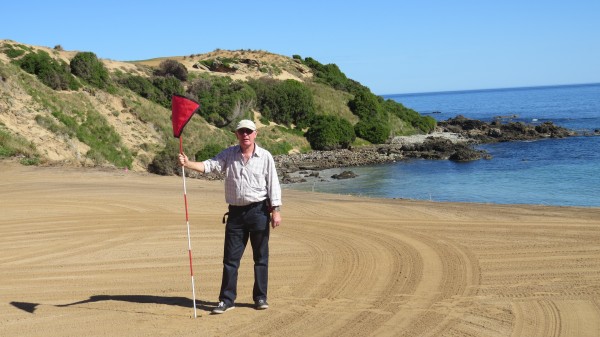
Duncan Andrews may have already earned himself critical acclaim in Australian golf circles for his work as the owner of The Dunes, but he’s now contributing to what could go down as one of the great golf courses in the world once it opens in October – Cape Wickham on Tasmania’s King Island. Roughly halfway between Victoria and Tasmania in the cold winds of Bass Strait sits King Island, long known for its premium local beef, seafood and cheese but soon to become a golf destination of global significance.
Cape Wickham’s chief superintendent Simon Muller – who juggles fortnightly visits to King Island with his full-time role at The Dunes – says the course remains on track for its scheduled opening on October 30. “Essentially we could have golfers there today if we wanted to but we’re not quite where we want to be at for opening,” Muller admits.
Cape Wickham was opened for more than 400 preview rounds over a six-week period throughout March and April. Many Australian and international golf writers joined a strong contingent of members from Andrews’ The Dunes to get an early taste of what Cape Wickham has to offer.
“We had all the greens 100 per cent playable. We have got 100 per cent coverage, we do on the majority of them, just a few of the holes still to be reseeded and grown in this winter period. We’re still not sure it will be open over the winters anyway with weather conditions,” Muller says.
Cape Wickham currently has a corporate marquee acting as a temporary clubhouse and will use the next few months to complete driveways around the clubhouse and finalise its 24 ‘container-style’ accommodation units, which will be able to sleep two people each. Muller – who has worked at the famed Kingsbarns Golf Links near St Andrews in Scotland – has boldly predicted Cape Wickham could earn even higher praise than Barnbougle Dunes on the northern coast of Tasmania.
“In terms of pure golf course, when you get a nice day out there with the blue skies and the beautiful turquoise blue bay and the green fescue, it’s just spectacular. In terms of being photographic, Cape Wickham is just unbelievable. Wickham has just got no weak holes,” Muller argues. “We’ve got no doubt that it’s a better golf course than Barnbougle. We’ve probably got two to three years of fescue really maturing and once it’s in its best condition, it’s a better course than Barnbougle.”
Andrews says he and Cape Wickham’s architects – Mike DeVries and Darius Oliver – immediately knew the site had immense potential. “When we were building it, we were saying, ‘this has got to be one of the best courses in Australia’, but you say that with a total bias,” Andrews says.
Eighteen holes at Cape Wickham is set to cost golfers $150. “It’s been extraordinarily expensive to build. No one’s going to walk in after paying $150 and say I’ve been dudded.” Andrews admits getting the Tasmanian Government to realise Cape Wickham’s potential to boost the state’s tourism industry was pivotal to the project. “We had to get the Tasmanian Government to agree to let us use the foreshore, the coastal reserve, which they did. If you think about it, all the holes that are on the water, are on government land. You can’t get that anywhere, that’s what made the difference.”





